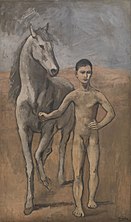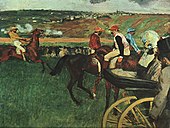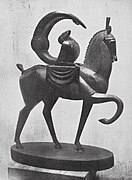Horses in art

Horses have appeared in works of art throughout history, frequently as depictions of the
Horses often appear in artworks singly, as a mount for an important person, or in teams, hitched to a variety of horse-drawn vehicles.
History
Prehistory


The horse appeared in prehistoric cave paintings such as those in Lascaux,[1] estimated to be about 17,000 years old.
Prehistoric hill figures have been carved in the shape of the horse, specifically the Uffington White Horse, an example of the tradition of horse carvings upon hillsides, which having existed for thousands of years continues into the current age.[2]
The
Ancient World

The equine image was common in ancient Egyptian and Grecian art, more refined images displaying greater knowledge of equine anatomy appeared in Classical Greece and later Roman work. [3] Horse-drawn chariots were commonly depicted in ancient works, for example on the Standard of Ur circa 2500BC.
The Greeks and Romans invented the
The horse was less prevalent in early Christian and Byzantine art, overwhelmed by the dominance of religious themes.
Renaissance and after

The
In the Baroque era, the tradition of equine portraiture was established, with artists such as Peter Paul Rubens, Anthony van Dyck and Diego Velázquez portraying regal subjects atop their mounts. Equine sporting art also became established in this era, as the tradition of horse racing emerged under Tudor patronage.[3]
18th and 19th centuries


George Stubbs, born in 1724, became so associated with his equestrian subjects that he was known as "the horse painter". A childhood interest in anatomy was applied to the horse. He spent eighteen months dissecting equine carcasses and had an engraver produce bookplates of his studies. These anatomical drawings aided later artists.
The mid-18th century saw the emergence of Romanticism, French artists Théodore Géricault and Eugène Delacroix were proponents of this movement and both portrayed the horse in many of their works.
Equine sporting art was popular in the 19th century, with notable artists of the period being
Rosa Bonheur became famous primarily for two chief works: Ploughing in the Nivernais (in French: Le labourage nivernais, le sombrage),[4] and, The Horse Fair (in French: Le marché aux chevaux)[5] (which was exhibited at the Salon of 1853 (finished in 1855) and is now in the Metropolitan Museum of Art, in New York City. Bonheur is widely considered to have been the most famous female painter of the nineteenth century.[6]
20th century
Subject genres
Military and war
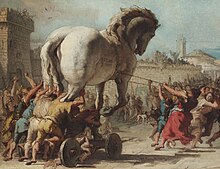

In the medieval period, cavalry battles and knights on horseback were portrayed by artists including Paolo Uccello and Albrecht Dürer. Uccello's tryptic The Battle of San Romano shows various stages of a battle. Dürer's engraving of "Knight, Death and the Devil", 1513 shows a military subject combined with an allegorical theme.
Sir Alfred Munnings was appointed as a war artist during World War I; he painted both the Canadian Cavalry Brigade and the Canadian Forestry Corps stationed in France. He considered his experiences with the Canadian units to have been among the most rewarding events of his life.[11]
Elizabeth Thompson, known as Lady Butler, was famed for her military art, especially Scotland Forever featuring a dramatic charge by the Royal Scots Greys.
Horse racing
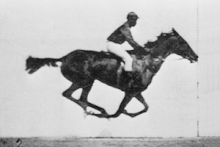
Thoroughbred racing was an inspiration for Romantic and Impressionist artists of the 19th century.
Generations of artists before Muybridge had portrayed the horse in a 'rocking horse' gallop, with the horse portrayed with both front legs extended forward, and both hind legs extended rearwards. Much more realistic representations were possible after the event of photography and Muybridge's work, but that did not necessarily lead to the impression of movement in the artwork. Luard writing in 1921 compares the running action of an animal with the run and rhythm of an air in music, but the instantaneous moment recorded by a photograph as a detached chord with little meaning or context.[13]
George Stubbs and Alfred Munnings have both left a vast body of work involving the racehorse.
In the 20th century, much of the artwork by John Skeaping involved the racing scene, including life-size bronzes of Hyperion and Brigadier Gerard and watercolours of racecourse action.
The American West

Artwork associated with the historic
Modern art
Inspired by El Greco's, Saint Martin and the Beggar, c. 1597–1600,
Hunting
Hunting scenes have been a common subject matter for equestrian painters. Specialists in fox hunting subjects include Cecil Aldin and Lionel Edwards.
Rural/working life
Lucy Kemp-Welch was well known for her depiction of wild and working horses in the landscape.
Gallery
-
Leonardo da Vinci's study of horses, c. 1490, – Monuments
-
Albrecht Dürer, Knight, Death and the Devil 1513, – Military and War
-
Peter Paul Rubens, Equestrian portrait of Crown Prince Władysław Vasa with the Battle of Khotyn in the background, 1624, – Baroque style
-
Théodore Géricault, An Officer of the Imperial Horse Guards Charging, 1812, – Military and War
-
Edgar Degas, At the Races, 1877–1880, Musée d'Orsay, Paris – Horse Racing
-
Saint Wenceslas, 1887–1924, Wenceslas Square, in Prague – Military and War
-
lithograph– The American West
-
Wassily Kandinsky, 1911, Reiter (Lyrishes), oil on canvas, 94 x 130 cm, Museum Boijmans Van Beuningen, Rotterdam – Expressionism
-
La Chasse (The Hunt), oil on canvas, 123.2 x 99 cm. Exhibited at the 1911 Salon d'Automne and Salon de la Section d'Or, Paris, 1912 – Cubism
-
La Femme au Cheval (Woman with a horse), oil on canvas, 162 x 130 cm, National Gallery of Denmark. Provenance: Jacques Nayral, Niels Bohr– Cubism
-
Centre Georges Pompidou, Paris – Post-Impressionism
-
Kuzma Petrov-Vodkin, 1912, Bathing of a Red Horse, oil on canvas, 160 × 186 cm, Tretyakov Gallery, Moscow – Symbolism
-
Jacques Lipchitz, 1914, Acrobat on Horseback (Acrobate à cheval) – Cubism
-
Musée d'Art Moderne de la Ville de Paris– Modernism
-
Chana Orloff, 1915, Amazone, bronze, 73.5 cm – Cubism, Art deco
-
Olaf Rude, 1918, Saint George and the dragon, oil on canvas, 99.7 x 79.9 cm, ARoS Aarhus Kunstmuseum – Cubism
-
Albert Gleizes, 1920–1923, Ecuyère (Horsewoman), oil on canvas, 130 x 93 cm, Musée des Beaux-Arts de Rouen, Centre Pompidou, 1998 – Cubism, Abstract art
-
Joan Miró, 1920, Horse, Pipe and Red Flower, oil on canvas, 82.6 x 74.9 cm, Philadelphia Museum of Art – Cubism, Surrealism
-
Abbott Pattison, 1954, Iron Horse, iron – Abstract art
See also
References
- ^ Lascaux caves official website.(retrieved 09/09/2011 Lascaux)
- ^ BBC video.Retrieved 09/09/2011
- ^ )
- ^ Galerie.roi-president.com
- ^ Metmuseum.org
- ISBN 0-13-182895-9, page 674.
- ^ Christie's New York, Isidore-Jules Bonheur
- ^ Isidore-Jules Bonheur, Le Grand Jockey (A Horse and Jockey), bronze, Sotheby's London, 6 June 2007
- ^ Joconde, Le Ministère de la culture, Portail des collections des musées de France, Bonheur Isidore Jules
- ISBN 978-90-420-1483-1.
- ISBN 0-660-57494-2.)
{{cite book}}: CS1 maint: multiple names: authors list (link) CS1 maint: numeric names: authors list (link - ISBN 0-8478-1234-0.
- ISBN 0-85131-445-7.
- ISBN 0-385-14738-4, p. 83.
- ^ "Rediscover Remington at the Clark" (PDF). Sterling and Francine Clark Art Institute. December 2007. Retrieved 19 May 2008.


